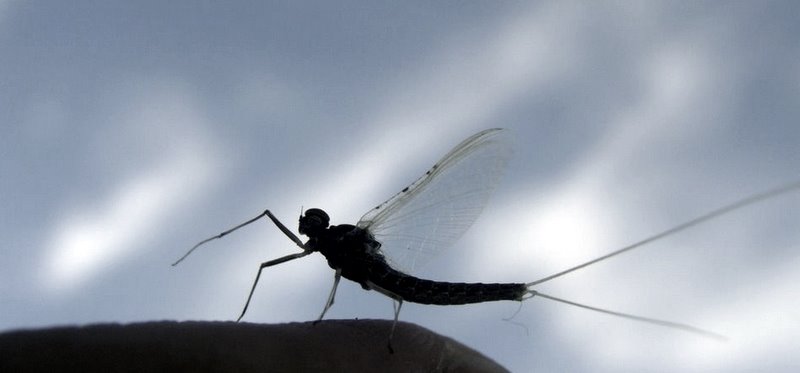Introduction
Hi All,
This will be a simple guide to the bugs in southern Alberta that are
important to anglers. It is an evolving document that will be changed
often as new information becomes available.
Fly Fishing Entomology can be as simple or complicated as one would like. Anglers can count the number of gills, while contemplating the size of the anterior region at the 13th instar. Or as simple as, a mayfly nymph is an aquatic bug with 2 or three tails and gills on the sides of their abdomen.
We'll keep it more to the simple side of things here.
Mayflies

Identification
Nymph shape: 2-3 tails, gills on abdomen, 1 toe per foot
Adult shape: Upwings, slender, 2-3 tails
Lifecycle:
Nymph > Dun > Spinner
Mayflies are the bug for fly fishermen. They can be critically studied and dissected to each of their Latin parts, or they can be grouped together in a couple of patterns in a few colours.
Mayfly nymphs can be split into four broad categories: Crawlers, Swimmers, Burrowers, and Clingers. Crawlers are generally flat and rectangular in profile; Swimmers are long, sleek, and streamlined moving fast like little fish; Burrowers live in the substrate and have robust legs to help them dig and long/big gills. Burrowers are typically nocturnal; Clingers have flattened bodies and strong legs to hold to rocks in flowing water.
Mayfly adults can be discerned by upright wings and generally slender bodies.
Most mayflies can be covered by a few simple patterns:
Hare’s Ear and pheasant tails for the nymphs;
Quigley Cripples and floating nymphs/emergers for the emerging pattern;
Parachutes, comparaduns, and traditional hackled flies for Adults; and
Soft Hackle and Poly wing spent patterns for spent spinners.
Caddis Flies
Identification
Nymph shape: worm with legs near head and hooks near tail. Sometimes in a stone or wood/vegetation case.
Adult shape: Tentwings, short bodies, moth-like wings
Lifecycle
Larva > Pupa > Adult
Caddisflies are an important food source for trout in Southern Alberta. Caddisflies adults can generally be identified by their folded wings.
There are dozens of different caddis patterns and one day one will work while another fails and the next day the opposite happens (it's really about presentation). Most caddis adults can be imitated by a selection of elk hair caddis patterns, size 14-18, in tan, green, and brown. Pupa can be imitated with the sparkle pupa in the same colours and sizes. Larva can be imitated with cased caddis patterns in a light blend and a dark blend of colours and caseless caddis (Czech nymphs, rock worms) in tan, green, and brown.
My preferred caddis patterns include Craig Matthews’ X-caddis, a variant of Ralph Cutter’s E/C caddis, and the good old deer hair sedge (a no-hackle version of the elk hair caddis).
Stoneflies
Identification
Nymph shape: 2 tails, gills in between legs, 2 toes per foot
Adult shape: flat-downwings, 2 tails.
Lifecycle
Nymph > Adult
Cheers,
Harps